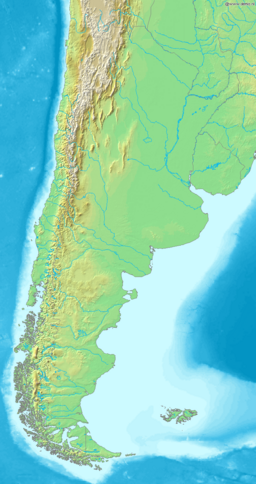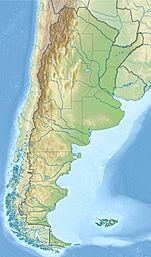Argentine Sea facts for kids
Quick facts for kids Argentine Sea |
|
|---|---|

The Argentine Sea, off the Atlantic coast of Argentina
|
|
| Location | Eastern shore of Argentina |
| Coordinates | 46°S 63°W / 46°S 63°W |
| Part of | South Atlantic Ocean |
| River sources | Río de la Plata, Colorado River, Río Negro, Chubut River, Deseado River |
| Basin countries | Argentina, Uruguay, Falkland Islands (UK) |
| Surface area | 1,000,000 square kilometres (390,000 sq mi) |
| Islands | Falkland Islands, Tierra del Fuego |
The Argentine Sea (Mar Argentino in Spanish) is a part of the Atlantic Ocean. It is located right next to the southern tip of South America, off the coast of Argentina. This sea stretches from the mouth of the Río de la Plata in the north down to Isla de los Estados in the south.
Its width changes a lot. It can be about 210 kilometers (130 miles) wide near Mar del Plata. But it gets much wider, up to 850 kilometers (530 miles), near the Falkland Islands. The coastline along the Argentine Sea is very long, reaching about 4,725 kilometers (2,936 miles).
Contents
Exploring the Argentine Sea's Geography
The Argentine Sea is in the South Atlantic Ocean. It lies off the southeastern coast of Argentina. It stretches from near Montevideo, Uruguay, all the way south to Tierra del Fuego. This sea is also about 800 kilometers (500 miles) north of Antarctica.
With a surface area of about 1,000,000 square kilometers (386,000 square miles), the Argentine Sea is one of the largest seas in the world. Its average depth is around 1,200 meters (3,952 feet). The deepest parts can reach about 2,224 meters (7,296 feet). The water in this sea has a salinity (saltiness) of 3.5%.
How the Sea Floor Looks
As you go south, the Argentine Sea gets wider. This is different from the land, which gets narrower. The sea floor has many flat areas called plateaus. These plateaus step down towards the east, like giant terraces.
Because of these stair-shaped plateaus, the Argentine Sea floor looks a lot like the Patagonia region on land. The Falkland Islands are also located on this wide underwater shelf of the Argentine Sea.
Understanding Sea Zones and Claims
Countries have special zones in the ocean next to their coasts. These zones give them rights to use the sea and its resources.
- Territorial Waters: This zone extends 12 nautical miles (about 22 kilometers) from the coast. A country has full control here, just like its land.
- Contiguous Zone: This zone is another 12 nautical miles (about 22 kilometers) beyond the territorial waters. Here, a country can enforce laws about customs, taxes, and pollution.
- Exclusive Economic Zone (EEZ): This zone stretches 200 nautical miles (about 370 kilometers) from the coast. In this area, a country has special rights to explore and use marine resources. This includes fishing, oil, and gas.
- Continental Shelf: This is the underwater landmass that extends from a continent. Countries can claim rights to the resources on and under their continental shelf.
Argentina has signed an international agreement called the United Nations Convention on the Law of the Sea. This agreement helps set rules for how countries use the oceans.
Disputed Areas in the Sea
Sometimes, different countries claim the same parts of the ocean. This happens in the Argentine Sea. Argentina and the United Kingdom both have claims around the Falkland Islands. They also have claims near South Georgia and the South Sandwich Islands.
The United Kingdom's claim around the Falkland Islands starts from the middle point between Argentina and the islands. It then stretches 200 nautical miles in other directions.
When claims overlap, the United Nations Convention on the Law of the Sea says that these disputed claims are not legally binding. They remain unresolved until the countries involved can agree on a solution.
Rich Marine Life in the Argentine Sea
The Argentine Sea is known for its mild temperatures. It gets both cold water from the Falkland Current (which comes from Antarctica) and warm water from the Brazil Current (from the north). This mix of currents helps create a rich environment for sea life.
There are twelve special areas in the Argentine Sea that have a lot of different kinds of plants and animals. Some of these areas are protected by international groups, some by the national government, and many by local provinces.
The sea is full of tiny plankton and different types of algae. These are the base of the food chain. You can also find many crustaceans, sardines, and anchovies. These smaller creatures provide food for larger animals.
Many amazing animals live here, such as penguins, cormorants, and even sharks. You might also spot whales, dolphins, and Burmeister's porpoise. On the shores, you can see fur seals, sea lions, and large southern elephant seals.
See also
 In Spanish: Mar Argentino para niños
In Spanish: Mar Argentino para niños


